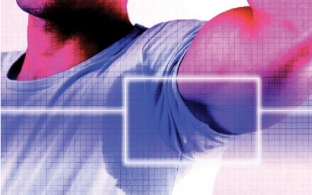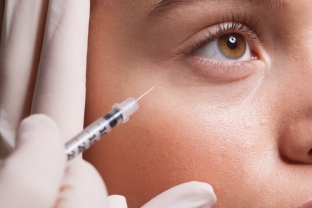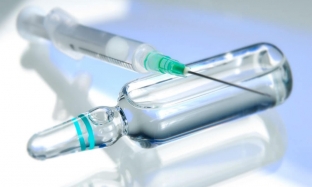Botulinum neurotoxin (BoNT) has been used in the aesthetic medicine field for many years to correct aesthetic skin imperfections such as expression lines. However, since the discovery of the dangerous neurotoxin produced by the bacterium Clostridium botulinum and the ability of BoNT to paralyze muscles, the substance has been used for a variety of cosmetic and non-cosmetic indications. Thus, botulinum toxin injections are a promising approach to the treatment of various dermatological diseases. Dr. Firas Al-Niami provides a review of the literature on the use of botulinum toxin in dermatology.
Mechanism of action underlying botulinum toxin treatment
There are 7 structurally distinct isoforms of BoNT (A–G), of which BoNT-A is the most commonly used (trade names: Botox, Dysport, Xeomin, Prosigne, Azzalure). In second place in terms of frequency of use is BoNT-B (trade names: Myoblocs, NeuroBloc). BoNT-A and BoNT-B – proteins consisting of heavy and light chains connected by a disulfide bond. The heavy chain of the neurotoxin binds to the cholinergic nerve ending, while the light chain inhibits the release of acetylcholine. BoNT-A and BoNT-B differ pharmacologically in the type of protein that cleaves the light chain: BoNT-A degrades SNAP 25, while BoNT-B – VAMP.
BoNT-A and BoNT-B – proteins consisting of heavy and light chains connected by a disulfide bond.
The most studied mechanism of action of BoNT is the inhibition of acetylcholine release at the presynaptic neuromuscular junction. The ability of BoNT to prevent the binding of acetylcholine to the postsynaptic receptors of the eccrine sweat glands and to suppress sweat production determines the effectiveness of the treatment of hyperhidrosis with botulinum toxin. Moreover, BoNT is thought to have an antinociceptive effect by blocking the action of substance P, so botulinum neurotoxin is also used to treat BMD and headaches.

Botulinum toxin treatment of hyperhidrosis: research results
Hyperhidrosis – a disease in which the eccrine glands produce excess secretion significantly impairs the quality of life of patients. Excessive sweating is the result of an abnormal reaction of the hypothalamus, which can affect the functioning of any eccrine sweat glands, but most often – in the palms, feet and armpits. Eccrine sweat glands in patients with hyperhidrosis are morphologically normal, but are stimulated by excess acetylcholine.
A multicenter, randomized, placebo-controlled study of the treatment of bilateral primary axillary hyperhidrosis with botulinum toxin showed that in 94% of patients in the treatment group (n = 242), the level of sweating decreased by 50% compared with baseline at 1, 4, and 16 weeks after treatment with 50 units of BoNT-A (Botox, Allergan, Irvine, CA). In the control group, this figure was only 36% of patients (n = 78).
A multicenter, double-blind, randomized controlled trial was designed to evaluate treatment with botulinum toxin type A (versus placebo) for primary axillary hyperhidrosis over a period of 52 weeks (n = 322). In this study, different amounts of the drug were used (75 or 50 units). The study showed a significant reduction in sweating (75%) in the therapeutic group, in the control group this figure was only 25%. Interestingly, the duration of the effect in patients who were injected with 50 units. the drug was 8 days more than in the group, which was administered 75 units. BoNT-A – 205 and 197 days respectively.
Many studies support the effectiveness of botulinum toxin type A treatment of hyperhidrosis.
A randomized, double-blind study of 11 patients was designed to evaluate the benefits of BoNT-A (120 units) in the treatment of palmar hyperhidrosis. The results showed a 26%, 26% and 31% reduction in sweating after 4, 8 and 13 weeks post-treatment, respectively (statistically significant). The ninhydrin test was used to assess the effectiveness of the treatment.
An intra-individual comparative study (n=19) evaluating the safety and efficacy of BoNT-A for the treatment of palmar hyperhidrosis demonstrated statistically significant improvements with botulinum toxin treatment on one arm compared with saline treatment on the other arm. In terms of side effects after BoNT-A injections, a study of 427 patients showed that 275 (64%) of them experienced local pain, and 103 (24%) – muscle weakness after injection of 75-100 units. Botox, Allergan.
Frey Syndrome – it is a form of localized sweating in the parotid region, accompanied by erythema during chewing, often associated with trauma or surgery in this area. It is believed that the mechanism of this disease is secondary and is associated with erroneous regeneration of parasympathetic cholinergic fibers and sympathetic cholinergic receptors in the skin. Available treatments include atropine, antidepressants, and neurectomy.
In one study, the authors treated 7 patients with Frey syndrome using 5-30 units of BoNT-A (Botox, Allergan). The intensity of sweating was determined by the results of the Minor test, and the frequency of recurrence of the disease was also recorded. Some patients did not require treatment 12-24 months after a single dose of BoNT-A (12.5 U, Botox, Allergan), while others received retreatment after this period.
Hyperhidrosis of the stump – a disease that often develops in patients with amputated lower limbs, which is difficult to treat. Topical astringents and iontophoresis provide minimal results in the treatment of this disease.
Injection of 100 units of BoNT-A (Botox, Allergan) into the stump has been reported to prevent hyperhidrosis in a 44-year-old diabetic amputee. Initially, there was a recurrence of the disease after 4 months, associated with the transposition of sweat from more highly located areas of the stump. Subsequent administration of BoNT-A to the target areas of the thigh allowed prolongation of anhidrosis (a total of 200 units were injected into the anterior and posterior thigh), and no recurrence of the disease was observed after 7 months.
After the introduction of 1750 units. BoNT-B 9 amputees experienced a significant reduction in sweating at 4 weeks (p = 0.027) and 3 months (p = 0.020).
Data on the treatment of pruritic dermatoses with botulinum toxin
Botulinum neurotoxin relieves symptoms of pruritus, including conditions such as chronic neuropathic pruritus, dyshidrosis, and idiopathic pruritus. Animal studies show that BoNT-A inhibits mediators associated with pruritus such as substance P and glutamate. Moreover, Schemlz et al. demonstrated that acetylcholine-responsive c-fibers were also associated with pruritus.
Small, double-blind, placebo-controlled study in 14 patients with pruritus induced by a histamine challenge demonstrated that 5 units of BoNT-A (Botox, Allergan) significantly reduced the intensity of pruritus and the area of the affected skin area. Laser Doppler imaging performed in part of the study also showed that BoNT reduced vasomotor activity in the target site.
Animal studies show that BoNT-A inhibits mediators associated with pruritus such as substance P and glutamate.
Dyshidrosis was treated with botulinum toxin type A (mean dose ? 162 units, Botox, Allergan) in an intra-individual study involving 10 patients. The side not treated with botulinum toxin was considered as a control. As a result of treatment, 70% of patients, according to the subjective assessment, noted a decrease in itching by 39% (on the treated side) and an increase in itching by 52% (on the untreated side). The authors suggested that an increase in symptomatic pruritus may be associated with compensatory hyperhidrosis. A further study involving 6 patients confirmed these results (with the introduction of 100 units of BoNT-A, Botox, Allergan). Botulinum toxin-induced anhidrosis is thought to have improved the symptoms of dyshidrosis and reduced the number of recurrences.
Open-label pilot study in 4 patients investigating the effects of botulinum toxin type A (20-80 units, Dysport, Ipsen Biopharmaceuticals Limited, Basking Ridge, NJ) in the treatment of lichen simplex pruritus through 4 weeks demonstrated the complete elimination of not only skin itching, but also some clinical symptoms.Fox-Fordyce disease – a rare disease accompanied by itching, most pronounced in areas of the skin with a high density of apocrine glands. Patients respond well to treatment with botulinum toxin (injection of 100 units of BoNT-A (Botox, Allergan) into the armpits), which is manifested in the reduction of papules and relief of itching.
Acantholytic diseases: possibilities of treatment with botulinum toxin
Hailey-Hailey Disease – an autosomal dominant acantholytic disease associated with a mutation of the ATP2C1 gene, which clinically manifests as erythema at the skin folds. Heat and sweating aggravate the disease, increasing discomfort and itching. BoNT can alleviate all of the above symptoms through inhibition of acetylcholine and substance P. Some clinical cases show improvement in the condition of patients with Hailey-Hailey disease when treated with botulinum toxin type A (50-125U, Botox, Allergan). One case report compared BoNT-A with conventional treatments such as dermabrasion and Er:YAG laser therapy. Thus, botulinum toxin may be a viable alternative for patients who cannot tolerate ablation.
Disease Daria – another autosomal dominant acantholytic disease associated with a mutation in the ATP2A2 gene. The manifestation of the disease includes oily warty papules on the folds of the skin and in the localization of the eccrine glands, which lead to the appearance of an unpleasant odor. Data on the treatment of Darier's disease with botulinum toxin are limited to the description of a case of improvement in the condition of one patient after the introduction of 100 units. BoNT-A (Botox, Allergan). The author has experience in the treatment of Hailey-Hailey and Darya disease
with botulinum toxin injections.
The use of botulinum toxin in the treatment of inflammatory dermatosesPurulent hydradenitis (GG) – chronic inflammatory dermatosis of the apocrine glands, which usually affects the muscular cavities and groin. This disease is often difficult to treat. To date, there are several case reports in which treatment with botulinum toxin type A resulted in significant relief of the symptoms of the disease, which is associated with the suppression of sweating.
A 46-year-old female patient with severe chronic suppurative hidradenitis (Hurley stage 2) responded well to adjuvant treatment with BoNT-A injections (50 units) with a remission period of at least 12 months. Prior to this, the patient had been treated with antibiotics, disgraced contraceptives, and a surgical drainage procedure for secondary abscesses. The author suggests that BoNT-A inhibits the secretion of apocrine glands, thus preventing the inflammatory response caused by follicular material in the pilosebaceous complex.
Botulinum neurotoxin has also been used in research to treat inflammatory dermatoses that are exacerbated by excessive sweating. A pilot study in 15 patients with skinfold psoriasis demonstrated that 50-100 units of BoNT-A (Botox, Allergan) improved subjective symptoms of the disease, as evidenced by objective photographic evidence, in 87% of patients at 2, 4, and 12 weeks post-treatment. Moreover, patients with psoriasis have a high concentration of substance P receptors in the skin. This means that botulinum neurotoxin theoretically reduces itching by inhibiting substance P and therefore prevents it from binding to multiple receptors.
Decalving folliculitis – This is primary neutrophilic scarring alopecia. In one clinical case, after injections of 60-150 units of botulinum toxin type A (Botox, Allergan), hair regrowth was observed. The authors hypothesized that inhibition of immune factors and BoNT-A cytokines reduces follicular inflammation.

Botulinum neurotoxin can also be used to reduce the appearance or amelioration of scarring problems, especially in areas of excessive muscle activity such as the upper forehead. BoNT can be administered either during scar formation or during suture removal time. In addition to inhibiting muscle activity, botulinum neurotoxin is believed to inhibit the action of fibroblasts and therefore reduce scar hypertrophy.
A randomized, double-blind, placebo-controlled study in primates showed a significant reduction in the severity of scarring after BoNT injections (analyzed by plastic surgeons) compared with a group that did not receive botulinum toxin (p<0.01).
There are several clinical cases of treatment of refractory vulvodnia with botulinum toxin. The analysis found that BoNT-A was effective in blocking nociception in the vestibule of the vagina.
Due to the vestibulectomy in one case, the long-term efficacy of botulinum toxin in the treatment of vulvodynia could not be assessed.
In a separate study, patients (n = 7) were found to experience a reduction in pain intensity after treatment with botulinum toxin (injection of 20-40 units of Botox, Allergan), but the number of injections required varied.
BoNT injections in combination with gradual dilatation have demonstrated efficacy and safety in the treatment of vaginismus (10 & ndash; 150 units).
Naik et al. recently published the results of a randomized, double-blind, placebo-controlled, 5-year pilot study in the treatment of painful cutaneous leiomyomas. 
2
were found to reduce pain and improve the quality of life of the patient, despite the lack of statistical significance. This may be due to the small sample size (n = 18). The study described was a single-centre and limited subjective measurement of pain intensity, gender variation within groups, and differences in distribution and localization of leiomyomas. The authors also hypothesized that pain was reduced by blockade of cholinergic nerves with botulinum toxin.Unpleasant body odor (bromidrosis), whether associated with hyperhidrosis or not, is also eliminated by treatment with botulinum toxin.
There are also several reports on the use of botulinum toxin for the treatment of redness and rosacea. Thus, botulinum toxin is a promising therapeutic option for non-cosmetic applications in dermatology.According to
Prime
.







Add a comment